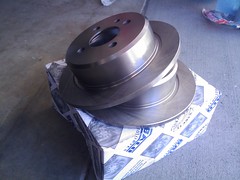The rear brake pads and rotors on my BMW were still the ones that came with the car when I bought it in 2005. They were worn out to the point the sensor was touching the rotor and although they may have had some life left in them I decided to replace them now rather than wait longer. The rotors were likely worn out beyond the minimal thickness suitable for re-surfacing (it turned to be true when I measured them) so I bought pads, wear sensor, rotors and rotor mounting internal-hex screws. It’s a simple procedure. This write-up is loosely based on the procedure described in the Bentley manual. Click on pictures to see notes indicating the location of various components.
Jack up the car and remove the wheels. Release the hand brake.
On the right wheel, disconnect the brake pad wearing sensor and release the connecting wire from the clip that secures it to the guide bolt cap.
Remove the plastic caps that cover the caliper guide bolts.
The next step was to remove the guide bolts themselves, and here’s where I noticed that I lacked the tool for it. The guide bolts have an internal hex head and my largest Allen key was still too small to fit in the opening. So here I am taking another trip back to Schuck’s in my wife’s car. This sort of emergency trip seems to happen every time I attempt a new maintenance procedure… I bought a full set of metric hex keys.
Remove the caliper guide bolts.
Remove the anti-rattle spring by pressing on it and pulling, and pull the caliper out with the brake pads. It should come out without effort.
Continue with the removal of the rotors. Start by unscrewing the brake pad carrier bolts.
Do not let the brake pad carrier assembly hang on the brake line. I suspended them with zip ties to the frame. S-hooks would do as well.
Remove the mounting screw from the front of the rotor and pull the rotor from the hub. If the rotor is stuck to the hub use a soft mallet to free it.
That’s when I noticed that the left-side shock absorber had a build-up of grease at the bottom. There is no motor oil in that area and the only place this could have come from was the shock itself. I traced the leak to the top part of the shock. To get to the source I pulled down the plastic boot that covers the piston (it was a bitch to put it back on the top cupped waster) and there it was: a puddle of clear oil on the cylinder cap. I’m pretty sure the shock is not supposed to leak. I must call BavAuto…
Install the rotors on the hubs. I used new mounting screws; the old ones were rusty. Clean the rotors with brake cleaner before installing the new pads.
Compress the piston back into the caliper to provide space for the new, thicker brake pads. I used a C-clamp. If the brake fluid reservoir is full to the brim, pushing in the piston may make the brake fluid leak through the screw cap of the reservoir.
Install the pads in the calipers and put the whole thing back on. Don’t forget the new pad wear sensor on the right wheel.
Cost breakdown
All parts purchased from Pelican Parts.
- ATE brake pad set - $37.25
- Brake pad wear sensor - $4.75
- Balo rear brake disks (rotors) - 2 x 33.75 = $67.50
- Brake Disc and Drum holddown bolt, 11mm Head - 2 x $2.00 = $4.00
- About 5 hours of work, including two trips to Schuck's
















